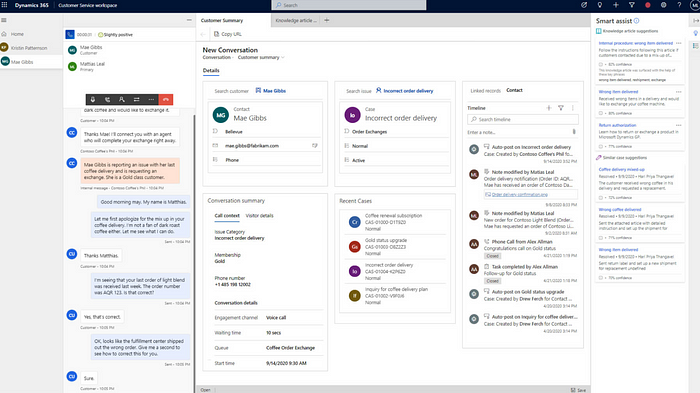Better Together: Dynamics 365 CRM & SAP — Part 4
In my previous post, we toured Dynamics 365 Sales and showed you how it could deeply integrate with SAP ERP to dramatically enhance the sales process end-to-end. Today, we’ll look at the service side of CRM by evaluating Dynamics 365 Customer Service.
D365 Customer Service: The Basics
D365 Customer Service offers a wide range of features for providing excellent customer service experiences. For customer service agents, it all starts with the dashboard experience shown in Figure 1. Within this dashboard, agents can quickly access active cases, cases that have been routed to their work queue, and open activities/follow-on tasks.

Figure 2 shows the in-app agent workspace. Within this workspace, customer service agents have access to customer data, case history, knowledge base articles, and so forth. The experience is further enhanced by AI-based features such as live call transcription (with real-time language translation), customer sentiment analysis, and Smart Assist — a sidebar panel which makes intelligent recommendations about relevant knowledge articles, historical cases, and others.

Agents record service incidents as cases in D365. Besides answering basic questions as to the “who”, “what”, “when” and “where” of an incident, case records are used to track service responsiveness against SLAs and other contractual requirements. As you can see in Figure 3 below, cases can be added to work queues and routed to different agents within the workspace experience.

D365 Customer Service: Advanced Features
In this section, we’ll highlight some of the more advanced features of D365 Customer Service. Here, once again we will see how Microsoft builds on the foundations of Power Platform and Azure to modernize and re-imagine the customer service experience for both agents and customers.
Omnichannel Communications
This is a real area of strength for Microsoft. With investments going back to Skype for Business, Azure Communication Services, and conversational agents, Microsoft has all the infrastructure pieces in place to support omnichannel communications. The communication channels supported include:
- Voice
- Chat
- SMS
- Microsoft Teams
- Social Channels (e.g., Facebook)
These channels are seamlessly woven into the agent experience, making it easy for agents to quickly respond to incoming requests and (re)route accordingly.
Service Scheduling
D365 Customer Service has excellent built-in service scheduling capabilities. Using the schedule board shown in Figure 4, schedulers can search for available agents based on service technician skillsets, work schedules, and available parts/equipment. Managers and technicians can then view these assignments from the D365 mobile app (which is included).

Intelligent Routing
Another area where Microsoft uses its best-in-class AI/ML capabilities is with Intelligent Routing. As you can see in Figure 5, incoming (omnichannel) requests can be analyzed and dispatched to agents based on a variety of factors including agent skill sets, capacity, customer prioritization, and so forth.

Embedded Analytics
D365 Customer Service is infused throughout with embedded analytics. These reports/dashboards provide both agents and management with a 360° view of performance and customer satisfaction. For example, Figure 6 provides an overview of performance across channels.

Integrating with SAP (and Beyond)
In my previous blog post, we reviewed options for master data integration between SAP ERP and D365 — notably with customers. On the transactional side of things, the primary integration point between D365 Customer Service and the Customer Service (CS) module in SAP ERP is the case record. Cases in D365 can be mapped fairly easily to service notifications in SAP (and vice versa).
Once this basic case-level integration is established, things get much more interesting. For example, if we want to check on the status of a case internally, we can follow the link from the service notification to its corresponding service order and monitor its progress. Another way we can track progress is by configuring service notification tasks and mapping those to activities in D365.
Service Scheduling
As mentioned earlier, D365 Customer Service provides advanced resource/service scheduling features out of the box. However, in order to be effective, D365 needs to have good visibility to available resources and constraints. If we assume that details about required parts/equipment are being maintained on the service order in SAP, then we have a few options to keep the two systems in sync:
- If we discover that we’re waiting on parts in SAP, then we can put the case on hold and capture notes in the timeline.
- For equipment records, we can link to the corresponding bookable resource in D365 and update its work hours to reflect availability.
- We can toggle the status on the pending service record in D365.
Knowledge Management
If you use SAP SuccessFactors LMS (or even some other LMS), it makes sense to use this as a data source for keeping your knowledge articles in D365 up to date. With some small customizations and SSO configuration (which may already be there), you can even link knowledge articles directly back to the LMS for more information (e.g., video tutorials, etc.)
Self-Service Enablement
Finally, if we zoom out a bit, the link from a case to a service notification/service order in SAP also opens up self-service. For instance, it’s surprisingly straightforward to create a customer self-service portal using Power Pages that naturally integrates with D365 Customer Service. In this type of experience, customers can use the portal to create and track service requests, get answers to frequently asked questions, schedule service, and even view outage maps. Similar services could also be provided by virtual agents.

Final Thoughts
We hope that you’ve enjoyed this whirlwind tour of D365 Customer Service, and that it showed you how complementary it is to SAP ERP. This is another case where D365’s flexibility makes it easy to modernize your customer service experience without necessarily disrupting years’ worth of investments in SAP CS — especially as it relates to settling up costs.
In my next blog post, we’ll take a tour through D365 Field Service and demonstrate how it can empower your field technicians as they maintain both internal and customer-owned equipment assets.

